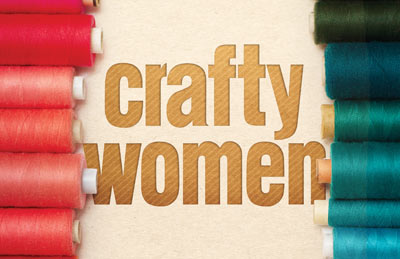
There’s no doubt the five craftswomen featured in the following pages have mastered that description to the proverbial “T” thanks to their creativity and dedication. There’s something uniquely satisfying about creating something memorable with your own two hands, but these talented women have taken their skills to another level.
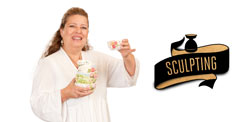
LAURA VENOSA DELLAPORTA
When it comes to creativity, Laura Venosa DellaPorta seems to have no limit to expressing herself. From her vintage fabric clothing and European-inspired market bags to her unique handmade jewelry, Laura’s flair for all things romantic, refined and rustic is obvious in everything she makes, much of which is offered in her charming downtown retail shop, Verbena, right behind Harry’s on the square. The shop was even listed as a favorite resource to shop in theNew York Timesbest-selling Romantic Prairie Stylebook.
Over the last three years, she’s been especially successful with her pottery items. So successful, in fact, that the Spring 2013 issue of Romantic Country magazine features her winsome bird bowls.
Laura first experimented with sculpting about eight years ago, making delicate Olivia clay roses (named after her daughter), which she fashioned into an extremely popular line of necklaces. Her designs appeared in numerous publications and shipped worldwide to both wholesale and retail outlets.
After the roses, Laura started designing and making clay rosary beads and crosses and, then in 2010, launched her current line of bird-themed pottery items.
“I love beautiful dishes, period. I like working with clay because it’s natural and organic,” says Laura, who spent 20 years in marketing in New York’s garment industry before moving to Ocala in 2002.
“I don’t use a pottery wheel because I prefer to build by hand and use my own hands to sculpt the clay rather than buying greenware that is pre-made,” says Laura, who is completely self taught.
Once she sculpts a piece into the design she wants, it must be fired, then hand-painted and fired again. The process for a single cup or bowl can be as long as three weeks from start to finish.
From teacups to bowls, Laura’s pottery dishes are beautiful but functional. It’s important to her that something pretty is also useful. Because the clay is lead free, the finished products can be used in the microwave. The designs—mainly birds—are all inspired by nature. Her signature color palette is soothing and simple: white, ivory, muted cream and delicate pastel hues. (“I never do brights,” she admits, “but I’m now adding whimsical colors to my pottery.”)
“I’ve always been drawn to birds; there’s something very soulful about them,” notes Laura. “I try to keep things timeless, simple, not over embellished. The pottery has a rustic feel to it that is completely my style, but my work doesn’t stay the same. It’s always evolving.”
One of her newest ventures is making porcelain eggs to sell in her “nest” dishes, and she’s also developing a new bowl collection. She creates many made-to-order pottery items for special occasions, such as weddings, baby showers and more.
“I love what I do,” says Laura, who often works 50 hours a week. “I think it’s my therapy.”
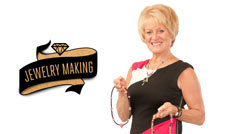
Lou Petty
Remembering someone special doesn’t always mean looking at a photograph. For Lou Petty, helping keep cherished memories alive involves using a tangible object. In this case, horsehair.
Lou, a lifelong horsewoman herself who, with husband, Tim, has owned Petty Quarter Horses in Ocala since 1996, knows all too well the ache of saying good-bye to a beloved equine companion. She also understands the desire to keep a memento—something you can see, touch and use, not just look at.
Lou has shown horses for over three decades. About 20 years ago, someone she knew in the show horse world asked if she could try to make something from horsehair. She took on the challenge and began making pins and brooches. When champion Rugged Lark died here in Ocala, Lou offered to make some jewelry from the stallion’s tail hair for grieving owner Carol Harris
“I usually make a round, hollow braid and that allows me to use wire to form it into the shape I want,” explains Lou. “I also learned beading, so sometimes I’ll use seed beads and make a pattern of them to sew into the braid. I’m currently making bronze and pure silver beads out of clay that I fire in the kiln, and I can personalize a piece with those.”
Lou designs and crafts every piece herself, making everything from rings and hat bands to bracelets, anklets, barrettes and bolo ties. She prefers to work with tail hair, as it’s longer and stronger than mane hair.
“I never make two things alike,” she confesses. “I don’t like to duplicate my own work, much less anyone else’s!”
A bracelet can take anywhere from four to 15 hours, depending on the complexity. Lou admits she doesn’t keep track of the hours she puts into a piece because she doesn’t want to hurry.
Lou’s work is on display at the downtown shop Artist’s Alley. She’s won awards for various pieces, including one from the Webber Art Museum at the College of Central Florida for a bronze pendant horsehair necklace she made.
Despite the accolades she’s received, Lou compares her jewelry making to showing horses: “You’re always trying to get better at what you do.”
Almost all of her pieces now are commissioned. She’s currently at work on a project for a woman in Kentucky who lost 17 horses and her home in a tornado last year.
“She lost everything except a 12-day-old foal who only survived because he was underneath two other horses. One horse lived a few days, and it’s from his hair that I’m making this piece.”
Lou enjoys the fact that when she’s making something, she’s constantly thinking of that person and their horse(s).
Horsehair is extremely durable—after all, horses are out in the weather all the time—and so is her horsehair jewelry.
“You don’t have to baby this jewelry, and getting wet won’t hurt it,” Lou says. “I want people to wear their pieces every day. For me, the best part of this is that rewarding feeling of making a special treasure for someone.”
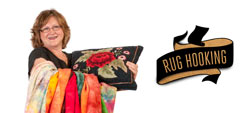
Karen Duncklee
If you’re seeking a hobby that yields immediate gratification, you should probably pass on rug hooking. Considering that some projects call for fabric strips 3/32nd of an inch wide, this is not something you’re going to finish overnight. Yet for Karen Duncklee, rug hooking is a truly satisfying way of honoring the past while creating something to enjoy in the future.
“Rug hooking started as a necessary item for the home—using up worn out clothing. It is now flourishing nationwide and has actually become a current, modern art form,” says Karen, who is originally from Wisconsin and moved to Ocala in 2005. “I’ve always been involved in some kind of handcrafts, whether it was sewing, quilting, knitting. I had seen rug hooking and said, ‘When the kids are out of the house, I am going to hook rugs.’ In 2006, I started lessons with Patti Gaufillet at her studio in Silver Springs.”
Karen discovered there are many classes and workshops; she continued her training and in 2012 became an Accredited McGown Teacher in Traditional Rug Hooking. Today, she makes projects for herself and as teaching examples and holds classes as well as monthly “hook-ins” at her home for others who enjoy the craft.
She buys 100 percent wool by the bolt from a woolen mill and then dyes it in colors suitable for each specific project. Karen’s used commercial patterns as well as some of her own original designs. She finds ideas everywhere and often takes a photograph or makes a quick sketch when she sees something inspiring.
Whether she’s making a pillow, a handbag, a table runner, floor rug or wall hanging, each project starts with strips of wool fabric, either cut with a cutter or, for wider strips, torn by hand. She uses a hook similar to a crochet hook, but with a wooden handle, much like what women used to hook rugs centuries ago. The backing is typically linen or rug warp (in the past women used old burlap feed and flour sacks), held taut in a frame.
Karen holds the strips under the backing and then pulls each one through the spaces forming a loop on top. The loops vary in size according to the width of strips used; the thinner the strips the shorter the loop size.
“I don’t count the hours involved in a project,” she says. “Sometimes, I only have 10 minutes to work; other times, I’ll have two hours. I’ve spent as long as a year working on a detailed project.”
Karen exhibits her work and has been a demonstrator at Ocali Country Days, the Florida State Fair and other events; she sells rug-hooking supplies through her online store at shadyhillrughooking.com and from her home.
“Creating a hand-hooked rug is still being done today as it was long ago, with the simple tools of a hook and strips of cloth,” Karen reflects. “In this fast-paced world of technology, it’s nice to sit and relax and enjoy a form of self expression that lets you tell a story.”
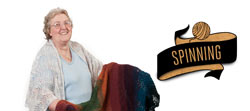
Anne Stumpf
A spinner who crochets and knits using the yarn she spins, Anne Stumpf considers herself a textile historian because she studies the craft of textiles and enjoys bringing history alive in her handiwork.
“I don’t have a degree in history, but you should see my library,” laughs Anne. She actually has an MBA, and her career was spent in health care and medical insurance management. Now retired, she can devote many hours to the hobby she says helped keep her sane during her busy career.
Originally from Maryland, Anne moved to Ocala in 2000. She started knitting at 20 but, in 1991, attended a spinning workshop in the Blue Ridge Mountains of Virginia. Presently in her late 60s (“but my brain is about 32!”), she continues to take classes and workshops to expand her knowledge.
Today, Anne has five spinning wheels and several hand spindles, including a few African spindles that are between 500 and 600 years old.
The spinning process starts with fibers, and there are many different types, ranging from cotton, silk and wool to alpaca, angora, yak and qiviut—now there’s a Scrabble word for you—which is the undercoat of the musk ox. (And just where does one buy qiviut? “You can either buy it online or go to Alaska,” Anne says matter of factly.)
“You name it, I spin it,” says Anne, whose bubbly, peaceful personality is perhaps the best testimony to her craft.
If the fibers aren’t clean, she washes them in mild soap and cool water, then rinses and lets them air dry. Then she “cards” the fibers to remove any tangles and debris. Fibers can be dyed, if desired, before or after spinning. Anne uses non-toxic dyes—even Kool-Aid and food coloring will work.
To spin the fibers, she sits at her wheel or picks up a hand spindle, puts a twist in the fiber and starts spinning.
“You get a lot of serenity from a spinning wheel,” says Anne. “I even have a charka, which is an Indian spinning wheel. This is what Ghandi used; he spun an hour a day until he died. It’s very meditative.”
You might find Anne demonstrating her craft at Ocali Country Days the second weekend in November or at other area festivals. While she delights in sharing her knowledge, she says her greatest pleasure is in continuing to learn and create.
“Most of what I make I give as gifts, but I do sell items at festivals,” says Anne, whose 50/50 cotton/wool socks are huge sellers. Socks are practical, but her favorite things to make are lacey, delicate shawls. (“They please the girl inside me.”)
“It’s so satisfying to go from cotton you picked in a field or fibers you get from a friend’s alpaca and take those fibers all the way through the process to see what it becomes. When I buy fibers, I often just hold and look at them and ask myself, ‘What does this fiber want to be when it grows up?’ Sometimes, it takes me a while before I sit down and spin because it has to tell me what it needs to be.”
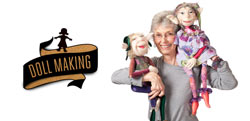
Jane Houck
A love of fantasy and a vivid imagination launched Jane Houck down the path as a doll maker.
“I’ve always believed in fairies since I was a child and have great fun imagining what a fairy looks like,” says Jane, who hails from North Carolina and moved to Salt Springs in 2000. She and her husband, John, make their home on Lake Kerr and were first drawn to the area because of his love of sailing.
While living in New Hampshire in the late 1990s, Jane took a workshop to learn how to sculpt doll figures from polymer clay. She wasn’t as thrilled about her own results with clay as she’d hoped. When she learned about the option of cloth dolls, Jane decided to go that route.
When prominent doll makers Elinor Peace Bailey and Susanna Oroyon encouraged her abilities, Jane started designing dolls and making her own patterns, some of which she’s been selling on the Internet for about 10 years. Now in her mid-70s, she focuses on whimsical figures, fairies and elves, ranging in size from a mere 7 inches to 22 inches tall. She’s even designed a few realistic dolls—including herself!—creating them for her own enjoyment and gifts.
Jane creates the doll body and head from plain, tightly woven cotton cloth (at least 250 thread count) and stuffs them with fiberfill.
“I have an image in my mind when I start,” she explains. “Once the body is completed, I tint the face with colored pencil and then finish painting it with acrylic paints for final definition. When you get the face done, it comes alive and becomes a functioning character and starts telling you what kinds of clothes it wants. I listen to these things; anybody who creates understands these kinds of messages and hints.”
Indeed, a peek at Jane’s dolls reveals the amusing personalities and attitudes these cloth creations contain.
Jane’s dolls are a labor of love, and she’ll often work six hours a day; one doll usually takes 30 to 36 hours. (“There’s no way to charge for the time in them!”)
From the doll’s bodies to wings (fairies fly, you know!) and gowns, Jane makes each piece by hand. No matter how much she loves a pattern, she doesn’t get in a rut.
“Once I have a new pattern, I only make it a few times before changing it or doing something different. I get bored quickly. I never totally duplicate a doll; they’re all unique in their own way. The most satisfying aspect for me is the creativity.”
When she isn’t making dolls, Jane likes beading, creating elaborate seed bead projects. She also fosters kittens for the Marion County Humane Society, keeping them until they’re old enough for spaying/neutering and adoption.






